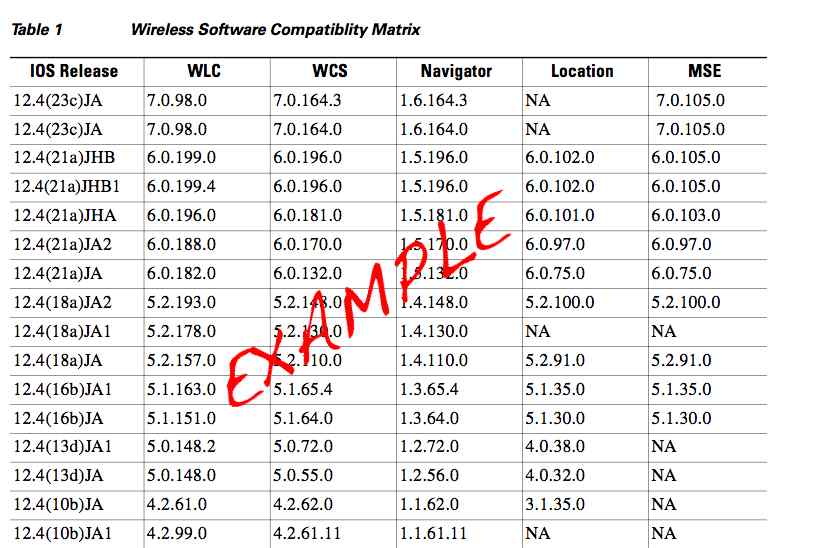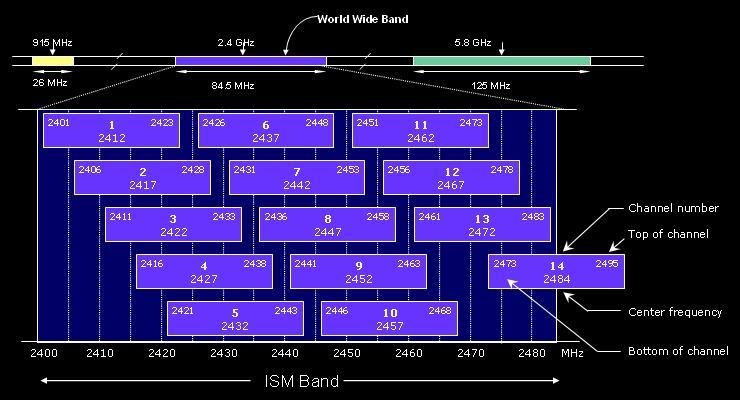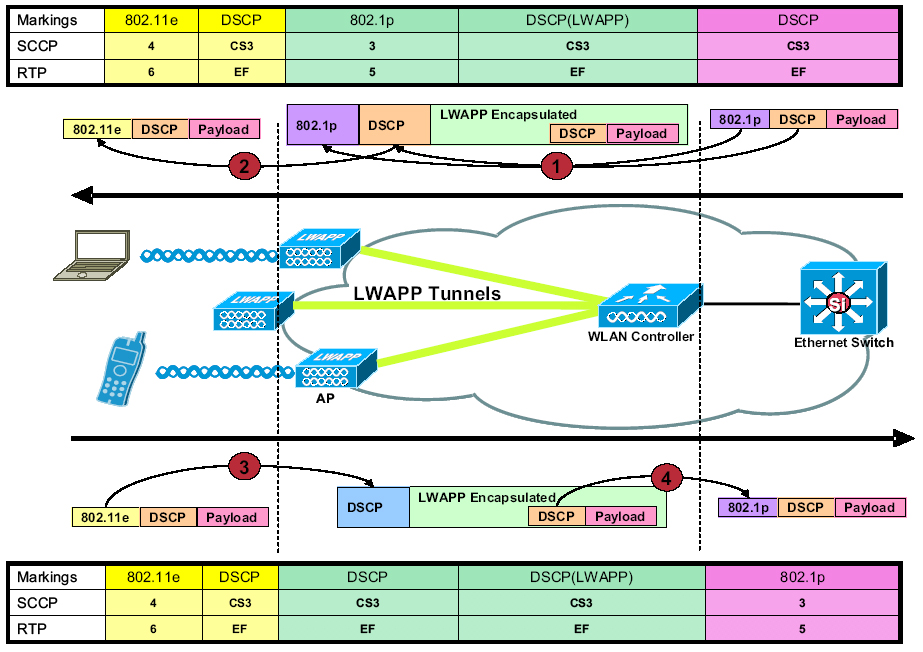What you NEED to know about TX Power and 802.11a (5GHz) on a Cisco LWAPP AP
 Friday, October 30, 2009 at 12:07AM
Friday, October 30, 2009 at 12:07AM Power, power power.... One of the MOST important design factors is selecting the proper radio TX power when designing any wireless network. You must consider your lowest common denominator and adjust your power equally between your client and AP for optimal design.
But did you know when you select different UNII channels in the 5 GHz band it changes the TX power of the AP? When selecting power on a cisco ap in the WLC you are presented with the power levels 1,2,3,4,5 etc. Most folks are aware on the 2.4 GHz side power levels.
1 = 20 dBm / 100mW
2 = 17 dBm / 50mW
3 = 14 dBm / 25 mW
4 = 11 dBm / 12.5 mW
But did you know depending on the UNII band you select the power levels are different on the 802.11a 5GHz radio. So if you select channel 36 at power of 1, you will be at a TX of 11 dBm MAX. If you select channel 161 at a power of 1, you will be at a TX of 17 dBm.
UNII 1 UNII 2 / 3
1 = 11 dBm / 12.5 mW 1 = 17 dBm / 50mW
2 = 8 dBm / 6.25 mW 2 = 14 dBm / 25 mW
3 = 5 dBm / 3 mW 3 = 11 dBm / 12.5 mW
4 = 2 dBm / 1.5 mW 4 = 8 dBm / 6.25 dBm
(Cisco Controller) >debug ap enable <Name of AP>
(Cisco Controller) >debug ap command "show controller do 1" <Name of AP>
Note:
"show controller do 0" is interface Dot11Radio0
"show comtroller do 1" interface Dot11Radio1
UNII-1 POWER LEVEL - Controller Power Level 1
(Cisco Controller) >
Thu Oct 29 10:37:02 2009: afa0:
Thu Oct 29 10:37:02 2009: afa0: !
Thu Oct 29 10:37:02 2009: afa0: interface Dot11Radio0
Thu Oct 29 10:37:02 2009: afa0: Radio AIR-RM1252A, Base Address 001d.70dd.afa0, BBlock version 0.00, Software version 2.00.22
Thu Oct 29 10:37:02 2009: afa0: Serial number: XXXXXXXXXXXXXXX
Thu Oct 29 10:37:02 2009: afa0: Number of supported simultaneous BSSID on Dot11Radio0: 16
Thu Oct 29 10:37:02 2009: afa0: Carrier Set: Americas (OFDM) (US) (-A)
Thu Oct 29 10:37:02 2009: afa0: Uniform Spreading Required: YesThu Oct 29 10:37:02 2009: afa0: Configured Frequency: 5180 MHz Channel 36 40Mhz, extended above (Power 1)
Thu Oct 29 10:37:02 2009: afa0: Allowed Frequencies: 5180(36) 5200(40) 5220(44) 5240(48) *5260(52) *5280(56) *5300(60) *5320(64) *5500(100) *5520(104) *5540(108) *5560(112) *5580(116) *5660(132) *5680(136) *5700(140) 5745(149) 576
5(153) 5785(157) 5805(161) 5825(165)
Thu Oct 29 10:37:02 2009: afa0: * = May only be selected by Dynamic Frequency Selection (DFS)Thu Oct 29 10:37:02 2009: afa0: Listen Frequencies: 5180(36) 5200(40) 5220(44) 5240(48) 5260(52) 5280(56) 5300(60)5320(64) 5500(100) 5520(104) 5540(108) 5560(112) 5580(116) 5660(132) 5680(136) 5700(140) 5745(149) 5765(153) 5785(1
57) 5805(161) 5825(165)
Thu Oct 29 10:37:02 2009: afa0: Beacon Flags: 0; Beacons are enabled; Probes are enabled
Thu Oct 29 10:37:02 2009: afa0: Configured Power: 14 dBm
Thu Oct 29 10:37:02 2009: afa0: Active power levels by rate
Thu Oct 29 10:37:02 2009: afa0: 6.0 to 54.0 , 14 dBm
Thu Oct 29 10:37:02 2009: afa0: m0. to m15.-4, 11 dBm, changed due to regulatory maximum
Thu Oct 29 10:37:02 2009: afa0: OffChnl Power: 14, Rate 6.0
Thu Oct 29 10:37:02 2009: afa0: Allowed Power Levels: -1 2 5 8 11 14
Thu Oct 29 10:37:02 2009: afa0: Allowed Client Power Levels: 2 5 8 11 14
Thu Oct 29 10:37:02 2009: afa0: Receive Antennas : right left middle
Thu Oct 29 10:37:02 2009: afa0: Transmit Antennas : right left, ofdm single
Thu Oct 29 10:37:02 2009: afa0: Antenna: external, Gain: Allowed 11, Reported 11, In Use 11
UNII-2/3 POWER LEVEL - Controller Power Level 1
(Cisco Controller) >
Thu Oct 29 10:34:21 2009: afa0:
Thu Oct 29 10:34:21 2009: afa0: !
Thu Oct 29 10:34:21 2009: afa0: interface Dot11Radio0
Thu Oct 29 10:34:21 2009: afa0: Radio AIR-RM1252A, Base Address 001d.70dd.afa0, BBlock version 0.00, Software versin 2.00.22
Thu Oct 29 10:34:21 2009: afa0: Serial number: XXXXXXXXXXXXXXX
Thu Oct 29 10:34:21 2009: afa0: Number of supported simultaneous BSSID on Dot11Radio0: 16
Thu Oct 29 10:34:21 2009: afa0: Carrier Set: Americas (OFDM) (US) (-A)
Thu Oct 29 10:34:21 2009: afa0: Uniform Spreading Required: YesThu Oct 29 10:34:21 2009: afa0: Configured Frequency: 5745 MHz Channel 149 40Mhz, extended above (Power 1)
Thu Oct 29 10:34:21 2009: afa0: Allowed Frequencies: 5180(36) 5200(40) 5220(44) 5240(48) *5260(52) *5280(56) *5300(60) *5320(64) *5500(100) *5520(104) *5540(108) *5560(112) *5580(116) *5660(132) *5680(136) *5700(140) 5745(149) 576
5(153) 5785(157) 5805(161) 5825(165)
Thu Oct 29 10:34:21 2009: afa0: * = May only be selected by Dynamic Frequency Selection (DFS)Thu Oct 29 10:34:21 2009: afa0: Listen Frequencies: 5180(36) 5200(40) 5220(44) 5240(48) 5260(52) 5280(56) 5300(60)5320(64) 5500(100) 5520(104) 5540(108) 5560(112) 5580(116) 5660(132) 5680(136) 5700(140) 5745(149) 5765(153) 5785(157) 5805(161) 5825(165)
Thu Oct 29 10:34:21 2009: afa0: Beacon Flags: 0; Beacons are enabled; Probes are enabled
Thu Oct 29 10:34:21 2009: afa0: Configured Power: 20 dBm
Thu Oct 29 10:34:21 2009: afa0: Active power levels by rate
Thu Oct 29 10:34:21 2009: afa0: 6.0 to m15.-4, 17 dBm, changed due to regulatory maximum
Thu Oct 29 10:34:21 2009: afa0: OffChnl Power: 14, Rate 6.0
Thu Oct 29 10:34:21 2009: afa0: Allowed Power Levels: -1 2 5 8 11 14 17 20
Thu Oct 29 10:34:21 2009: afa0: Allowed Client Power Levels: 2 5 8 11 14 17 20
Thu Oct 29 10:34:21 2009: afa0: Receive Antennas : right left middle
Thu Oct 29 10:34:21 2009: afa0: Transmit Antennas : right left, ofdm single
Thu Oct 29 10:34:21 2009: afa0: Antenna: external, Gain: Allowed 11, Reported 11, In Use 11
 George |
George |  7 Comments |
7 Comments | 














Reader Comments (7)
If you do a "show ap config 802.11a " part of the output for the a radio will be
Tx Power
Num Of Supported Power Levels ............. 8
Tx Power Level 1 .......................... 17 dBm
Tx Power Level 2 .......................... 15 dBm
Tx Power Level 3 .......................... 14 dBm
Tx Power Level 4 .......................... 11 dBm
Tx Power Level 5 .......................... 8 dBm
Tx Power Level 6 .......................... 5 dBm
Tx Power Level 7 .......................... 2 dBm
Tx Power Level 8 .......................... -1 dBm
Then for the B radio
Tx Power
Num Of Supported Power Levels ............. 8
Tx Power Level 1 .......................... 20 dBm
Tx Power Level 2 .......................... 17 dBm
Tx Power Level 3 .......................... 14 dBm
Tx Power Level 4 .......................... 11 dBm
Tx Power Level 5 .......................... 8 dBm
Tx Power Level 6 .......................... 5 dBm
Tx Power Level 7 .......................... 2 dBm
Tx Power Level 8 .......................... -1 dBm
However the in the channel and power guide, it shows B max power as 20 dBm, G max power as 17 dBm. Here is a link for the 1242.
http://www.cisco.com/en/US/docs/wireless/access_point/channels/lwapp/reference/guide/1240_chp.html
Correct on your assessment of the basic power rates, however you are overlooking the power settings on 802.11a UNII bands.(Which btw, is not in ANY Cisco documentation). DEPENDING on the 802.11a UNII channel you select on the access point. The TX power changes by default. Suppose you have a 1131 on channel 36 -- AT max TX will be 11 dBm. If you select channel 149 on that same 1131 at max your TX power will be 17 dBm. . Look very carefully at the UNII1 and UNII2/3 in my post. You will only find this with the "show controller do 0" cli command.You won't find this documented in recent Cisco documentation.
I understand that and actually that link I posted does show the max power for the different UNI II channels. It also shows the 20/17 max power for B/G.
The point I was trying to make is that the Cisco documentation could be a lot clearer and more complete. A chart for each channel, in each regulatory domain at each controller power level would be a good start. (Your chart does not show the 15 dBm controller power setting 2).
Joe, you hit the nail right on the head, "The point I was trying to make is that the Cisco documentation could be a lot clearer and more complete. A chart for each channel, in each regulatory domain at each controller power level would be a good start".
George,
Do you know why they limit the max power in UNII-3 to 17 dBm (50 mwatts) and do not allow full power 20dBm (100 mwatts)?
FCC regulations for IR (aka TPO) max power for UNII-3 and is 30 dBm (for both PtMP and PtP)
Thanks
Zach
Thats a great question and I wish I had the answer. I will say, having an internal access point with TX over 100mW (20dBm) is a bit much. So that wouldn'tmake sense .. but as far as going to 100mW, not sure.
I was out working on a site the other day that was running 100+ 1242s with WLC on 7.0 code. The signal strength was not up to par after surveying to find the issue. I ran debugs to find that what I thought about UNII2&3 was not true at all. For the last few years I thought that power level 1 was 17 dBm on UNII2&3... aka, 50 mW. I changed the name to the 1242 to protect the innocent.
UNII-1 channels = 36,40,44 & 48
UNII-2 channels = 52,56,60 & 64
UNII-2e channels = 100,104,108,112,116,120,124,128,132,136 & 140
UNII-3 channels = 149, 153, 157 & 161
debug ap enable TEST-1
debug ap command "show controller do 1" TEST-1
<lots of output omitted>
TEST-1: -Channel Range- -------Rates------ Max Power Allowed
TEST-1: 36 to 48 by 4 6.0 to 54.0 11
TEST-1: 52 to 60 by 4 6.0 to 54.0 17
TEST-1: 64 to 64 by 4 6.0 to 54.0 11
TEST-1: 100 to 116 by 4 6.0 to 54.0 17
TEST-1: 132 to 140 by 4 6.0 to 54.0 17
TEST-1: 149 to 153 by 4 6.0 to 54.0 17
TEST-1: 157 to 157 by 4 6.0 to 54.0 14
TEST-1: 161 to 161 by 4 6.0 to 54.0 11
Looks like UNII-2 has three out of four channels that can be 17 dBm, and UNII-3 has only two out of four channels that can to 17 dBm. I think a few of us should collaborate and make a comprehensive list/chart of what channels can transmit at the power rates.
I don't understand why I can't google this information quickly and find it on CCO.